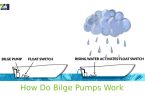What comes to your mind when someone talks about a kayak? For me, I see a strong person paddling a small inflatable boat across the water or struggling in whitewater rapids. Maybe, that’s the picture most people have. A lot of people have assumptions and concerns when it comes to safety. May it leak while in the middle of the sea? Can it handle a person’s weight? Is it durable? Well, don’t worry. We will discuss all these and more about inflatable kayaks and answer the question, are inflatable kayaks safe?
Table of Contents
Are Inflatable Kayaks Safe?
Kayaking is the best way to connect with nature, to relax in the outside world either by yourself or with a partner. But as relaxing as it may sound, you need the necessary equipment, basic knowledge and skills. Without many thoughts on popping or sinking, you may rely on inflatable kayaks in most of the tough conditions. They have a unique design with supports and stability.
The important thing is to understand how a kayak work and which ones are safe for a certain occasion. For example, you may wonder, are inflatable kayaks safe for fishing? In a word, yes! But before going for one, you need to know the kayaks specifications. You cannot use a whitewater kayak for this specific reason. Inflatable kayaks are good for fishing because they are easily portable, are noiseless and you can approach different fishing points without any difficulty.
There are different kayaks for different purposes. Touring kayak is good for a tour. Others include kayaks for children, sit-on-top kayaks, white water kayaks, flat water kayaks, and many more. To answer the question about kayak safety, we need to explain essential parts of your boat and what you may expect.
Know Your Vessel First
First things first, let me explain what makes an inflatable kayak. There are several things to look at before purchasing. It is imperative to know what you want in one so that you get the results you desire.
You may get confused with the terms used to define some of the kayaks, but some of the things to look at include buoyancy, construction, durability, rigidity, setup, stability, etc. Let’s get started and discuss each of them in detail.
1. Construction and Design
Inflatable kayaks are constructed typically from durable synthetic amalgams. These last for long and can be transported easily. Polyvinyl Chloride (PVC), Hypalon and Nitrylon are common choices when it comes to fabrics. Most kayaks come with multi-layered combinations of the above materials to yield longevity, optimum strength, and performance.
PVC is the most economical material but has vastly improved over the years with advanced technology. But, it’s vulnerable to intense sunlight and not resistant to certain chemicals or excessive abrasion. It is advisable to treat it with heavy-duty UV protection.
Nitrylon is slightly stronger than PVC. It is easy to patch and puncture-resistant with great usability during cold weather. If you are looking for an inflatable fishing kayak, choose one that’s built with nitrylon that makes the kayak resistant to tears and wears. Hypalon kayaks are the most expensive options, but they offer super performance and enhanced safety.
Another important thing to consider is multiple air chambers. This increases buoyancy, and just in case, something happens to one chamber, you’ll still be safe. Check to see if your kayak has passed the required standards from an appropriate authority, such as the Yacht Council or International Standards Organizations (ISO) certification.
2. Material
Three types of materials are in use. The outer coat is made with synthetic rubber and several layers of polyester and nylon. The inner coat uses neoprene fabric. The synthetic rubber protects the kayak against weathering and abrasions. Polyester or nylon gives the boat the strength it needs. The neoprene fabric allows no air to pass through and is responsible for making the kayak airtight.
3. Setup
The setup procedure has to be simple and doable in a few minutes. Just inflate it by pumping it with a foot pump, hand pump, or an electric pump.
Some of the kayaks include their own pumps and the valve installation package. You may inflate your boat at home or just before you hit the waters. Make sure that the pump you use comes with their own valves or check on the kayak first.
Secure the hose to the valve first. Make sure to inflate both air chambers. Start with the floor air chamber first, then go to the other. A hand and foot pump can take 5-8 minutes to inflate while an electric pump will take 2 minutes.
4. Rigidity and Stability
Once you’ve inflated the kayak, you’ll be able to check on the ‘stability’ thing. The important thing here is to get the kayak fully inflated because an under-inflated kayak will not be stable enough. Some of these kayaks use a metal framework or inflatable sections that act as a rod keep the kayak straight and stable as you paddle.
5. Buoyancy
This determines the amount of weight the kayak can carry. We have seen a couple of the normal kayaks that capsized while running through rapids. It can be quite a hassle emptying the boat and getting back in. So, how safe are inflatable kayaks when it comes to buoyancy? They are filled with air and easy to keep floating even when they may capsize. Also, the lightweight nature makes it easier to empty the boat of the water.
6. Durability
With advanced technology, inflatable kayaks consist of improved multi-layer material. The materials are carefully chosen to be rugged, strong, and resistant to wear and tear. Polyester and nylon are more durable than other materials.
So, whether you are passing through sharp objects on the river bed or rocky waters, you don’t have to worry about getting it damaged. The multi-layer materials are tear resistant in such cases and thus you have a guarantee that your watercraft will serve you for a very long time.
7. Destinations/Locations for Inflatable Kayaking
Finally, you may wonder what the safe places to use an inflatable kayak are. These watercrafts can be used for fishing, exploring nature, touring or cardio exercises. Are inflatable kayaks safe in the sea? Well, we’ve got them in the rivers and fast moving waters several times and once in the sea. Based on the findings, the sea will just be as safe as any other water bodies. It is advisable to stay close to the shore or paddle carefully being as much close to the shoreline.
Unveiling the Myths
There are a lot of misconceptions surrounding inflatable kayaks. Let us go through the myths and hopefully you’ll feel secure.
An Inflatable Kayak Is Likely to Pop as It Hits a Big/Small Rock We get this because some people view inflatable kayaks as a normal swimming floater. But, this is not the case since inflatable kayaks are made with strong multi-layer materials. Some people have even gone to the extent of trying to pop them but in vain.In case you encounter a rock, the heavy-duty PVC shell contributes to drift the boat away from the rocks without any damages.
An Inflatable Kayak Is Not Stable Most inflatables come with a broader base that takes care of the boat’s stability. Some models allow the kayaker to stand comfortably on them. So you can feel as confident standing on them as much you feel on a regular fishing kayak. The multiple air chambers ensure adequate buoyancy. So, the wider your inflatable; the more stable it should be. Inflatable Kayaks Are Hard to Maneuver and Slow This depends on the specific model you choose. Some inflatables include an optional rudder or a skeg to help the user to maneuver nicely in flat water. Also, a good one tracks well and runs fast. You Are Likely to Sink If the Inflatable Kayak Gets a Tear Not true! A tear on the kayak does not drown you. With several air chambers, the kayak doesn’t allow quick leaks; so you can paddle back to the shore before getting endangered. The inflatable kayaks do come with their own repair kit to let you patch up the tear quickly. Inflatable Kayaks Are Costly It depends on the quality and manufacturer of the product. Some are a bit expensive than the others due to a few more features. The price may range from $100 to $2000. Inflatable Kayaks Are Not Long Lasting Not true! Heavy-duty materials like Nitrylon, PVC, and Hypalon contribute to a relatively strong construction for inflatables. Most of these materials are multi-layered, and so the fear of durability is addressed too. You Cannot Drag an Inflatable Kayak on the Shore Of course, you will need to drag the kayak to the riverbank or shore to get it in or out of the water. They are designed for this. Inflatable Kayaks Are Difficult to Maintain It is important to take care of your product no matter what. Inflatable kayaks are as good as most ones with easy maintenance. All you need to do is pack it when completely dry so that molds can be avoided. Also, keep it away from extreme heat. Inflatable Kayaks Cannot Withstand Whitewater Remember that different kayaks are made for different purposes, and thanks to some manufacturers who have brought inflatable whitewater kayaks. It Will Not Be Easy to Go Back in When You Fall Out It is not too difficult to get back in the kayak if you fall out. It will be much easier since we have seen people falling out in huge rapid and getting back on the kayak in just seconds.So, What’s Left to Keep in Mind?
All you need to know now is how to be safe. Inflate the kayak fully. Get yourself ready both physically and psychologically. Remember that kayaking is tough and requires practice. Also, you can set a trolling motor in your kayak for hands-free mobility. Choose good batteries that will help you explore a greater distance on your kayak.
Conclusion
So, are inflatable kayaks safe? Well, we’ve discussed all you need to know about them. Forget about the myths and hearsays. A good quality inflatable kayak may offer you a nice way to go outdoors and enjoy the weekend rather than keeping you confined at home.








Leave a Comment